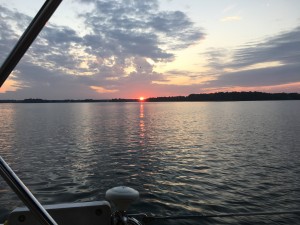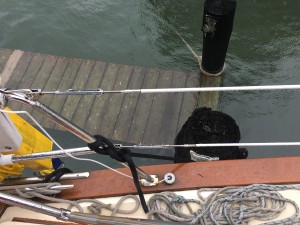“Warming of the climate system is unequivocal, as is now evident from observations of increases in global average air and ocean temperatures, widespread melting of snow and ice, and rising global average sea level.” (UN Global Warming Report)
On Friday, November 3rd the city of D.C. opened the Frederick Douglass bridge at midnight, and Sue and I sailed through to the James Creek Marina on the Anacostia River and docked for the
night. The next morning, we met our three adult children (Kateland, Sarah and Jonathan), Matt (Kateland’s fiancé), and our niece and nephew (Cricket and Ben) for a sail down the Potomac River to George Washington’s farm estate at Mount Vernon. The temperature dropped 30 degrees from the previous day and it felt more like fall with assorted red, yellow, and green leaves flanking the river banks on the Maryland and Virginia sides of the river.
The channel branching off to Mount Vernon, 14 miles downstream of the Anacostia, was quite narrow and shallow. As Tusen Takk draws 4 ½ feet and the chart showed 4 to 5 feet of depth at the dock, we dropped anchor 100 yards off the dock and ferried our tribe of history explorers ashore in our dinghy. There was something magical about sailing on river-time down the Potomac to Mount Vernon that made its history come alive. We could easily imagine George Washington plying these waters on his commercial fishing ventures (he made as much money from fishing as he did from agriculture). Our son, Jonathan, obviously moved by the historic-tenor, struck an iconic pose at the front of the dinghy commemorating Washington’s famous river crossing (wrong river, but classic pose). After tying off
the dinghy on the pier, we walked up toward our first President’s colonial mansion. As we broke out of the wooded path into the pasture area 500 yards below Martha’s and George’s historic home, we were greeted by a dozen redcoats galloping on horseback across the field with a dozen or more hounds in pursuit – a mock fox hunt (see pic at right). After the show, the crowd got to pat the meticulously groomed horses and skittish dogs up close and personal. We then toured a number of buildings including the slave quarters, kitchen, stables, blacksmith space and greenhouse – all of which are historic replicas of what life was like at Mount Vernon in the late 1700s.
Did you know that George Washington was a slave holder for 56 years, but spoke frequently of his desire to end the practice. He freed his slaves in 1799 – the only Founding Father to free his slaves in his will. For a brief historic video summarizing slavery at Mount Vernon, check out this link on slavery.
Slavery in the 1700s, of course, was a culturally accepted practice. And yet, Washington was disturbed by it and eventually freed his slaves. I had to wonder about the words in the Declaration of Independence, so fresh to our Founding Fathers: “We hold these truths to be self-evident, that all men are created equal…” I could sense the moral conflict that Washington wrestled with… And just as Washington wrestled with moral conflict in his time, so do we today. Over 200 years later, racial inequality still plays out in our country. Burning dirty fossil fuels pollutes the air we breathe and the water we drink and is a major cause of our warming climate, disproportionately impacting the poor and communities of color. And when there are clean, renewable, and economically viable alternatives, this becomes a disgrace and moral failure of our time. Just like Washington, we too are wrestling with moral issues like pollution and climate change. Do we even see these as moral issues? Do we acknowledge pollution as a problem and then turn away to the concerns of daily life because it is not impacting us directly? Standing in the slave quarters of Mount Vernon, I saw a parallel to moral blindness in the 21st Century.
After visiting Mount Vernon, we sailed another 15 miles down the Potomac to the Marine Corps Marina at Quantico where we docked for the night. The next morning, our family headed back to D.C. from Quantico as Sue and I continued sailing down the Potomac to the Boat House Marina in Colonial Beach, Virginia. Note: the Boat House Marina donated dock space for Tusen Takk in support of our climate and ocean conservation programs. The next day we completed our Potomac River leg and sailed out into the Chesapeake Bay and down to Ingram Bay Marina, providing a discount dock space, nestled in a quaint lagoon in Reedville, Virginia.
From there, we sailed to Norfolk where the Virginia Boat and Yacht Marina donated a slip for several nights (on the Portsmouth side). Along the way, we saw terns tucking their wings and diving head first into the water to capture fish, pelicans gliding inches from the water, and dolphins following us for miles surfing in the wave created off our bow and wake-riding our stern wave. Did you know why pelicans (and other birds) fly so low to the water? Skimming close to the water allows birds to take advantage of an aerodynamic phenomenon known as ground effect. When a bird, or an airplane, flies less than a wingspan’s distance from the ground, they experience an increased lift and decreased aerodynamic drag. You may have experienced the same phenomenon in an airplane – just before touching down, there is a feeling that the aircraft is floating.
After several long sailing days, Sue and I spent a day doing errands, laundry, etc. before Sue headed back to D.C. I then met up with my brother, Jonathan, an officer in the U.S. Navy, and prepared for a sailing trek to North Carolina. As my brother is in the Navy and we sailed into Norfolk, the largest naval base in the world and an epicenter for concern about sea level rise, it seemed fitting to take a look at what the U.S. Department of the Navy has to say about climate change and rising sea level.
Many people are concerned about climate change and how a changing climate will affect the ocean. Scientists have determined that global sea level has risen approximately 0.1 inches per year since 1900. Sea levels are rising primarily due to two factors: First, as our oceans warm due to increasing global temperature, seawater expands – taking up more space and causing a rise in water level. Secondly, as glaciers over land melt, this adds increasing water to the oceans.
According to a report from the Union of Concerned Scientists, Naval Station Norfolk and 17 other military installations on waterfront property are facing hundreds of floods a year, and in some cases, may be mostly submerged by 2100 (see UCS SLR Report2016). Key findings that impact the Navy, include:
- By 2050, most of the coastal installations will see more than 10 times the number of floods they experience today.
- By 2070, half of the sites could experience 520 or more flood events annually—the equivalent of more than one flood daily.
- By 2100, eight bases are at risk of losing 25 to 50 percent or more of their land to rising seas.
- Four installations—Naval Air Station Key West, Joint Base Langley-Eustis, Dam Neck Annex, and Parris Island—are at risk of losing between 75 and 95 percent of their land by the end of this century.
- Flooding won’t be confined to the bases. Many surrounding communities will also face growing exposure to rising seas.
The Navy recognizes sea level rise as an imminent threat. It would be hard for them not to. For example, the Naval Station at Norfolk floods ten times a year. The main entry road swamps, and crossing from one side of the base to the other becomes impassible. Sea level rise at Norfolk has risen over 14 inches since World War I when the base was built. The seas are rising at twice the global average here due to ocean currents and low-lying geology. For more information on sea level rise and its impact on the military, check out this National Geographic article: “Who’s Still Fighting Climate Change? The U.S. Military.”
It’s important to acknowledge that climate change poses an existential threat to humans and to all life on planet Earth (sea level rise being one symptom). There is no debate whether our climate is warming. It is warming. And burning polluting fossil fuels dumps 110 million tons of manmade global warming pollution into the atmosphere every 24 hours. That’s the equivalent of 450,000 atomic bombs of excess heat energy pumped into the atmosphere every day! And just as George Washington wrestled with the moral issue of slavery and eventually freed his slaves, so we today need to acknowledge the moral issue of climate pollution and take action to stop it.
It is also important to emphasize that solutions to the climate crisis exist today, and we have a moral responsibility to employ them! We are a people who care about our children and grandchildren. We want our children to inherit a healthy environment to live in. Developing clean, healthy and renewable energy will enable our children to breath clean air, drink clean water and inherit a livable climate while also creating sustainable jobs for their future. And we all have a role to play here; check out the Climate Reality Project’s Seven Solutions to the Climate Crisis.
Did you know that every hour the Earth gets as much energy from the sun as we need to run the entire global economy for a year. That’s a WOW! If we can harvest and use a fraction of that, we can make a lot of progress toward solving the climate crisis and helping local economies at the same time.
P.S. I wrote this blog on Tusen Takk in Portsmouth, Virginia (across the Elizabeth River from
Norfolk), and as Sue and I got ready to step off the boat onto the dock, the dock was 8” under water (see pic to left). Yes, it was high tide, but the dock was built before sea level rise was an issue. Talk about timing…
Stay tuned: Our next blog will look at 7 mega trends that can help beat global warming.
To subscribe to (or unsubscribe from) these blog posts, write to jonathan@cellonline.org.
*CELL is currently accepting applications for college sustainability focused study abroad programs, to Iceland, Central America, Ecuador, and Scotland. Faculty may contact CELL regarding custom programs for your college. Go to cellonline.org for more information and to apply.”




